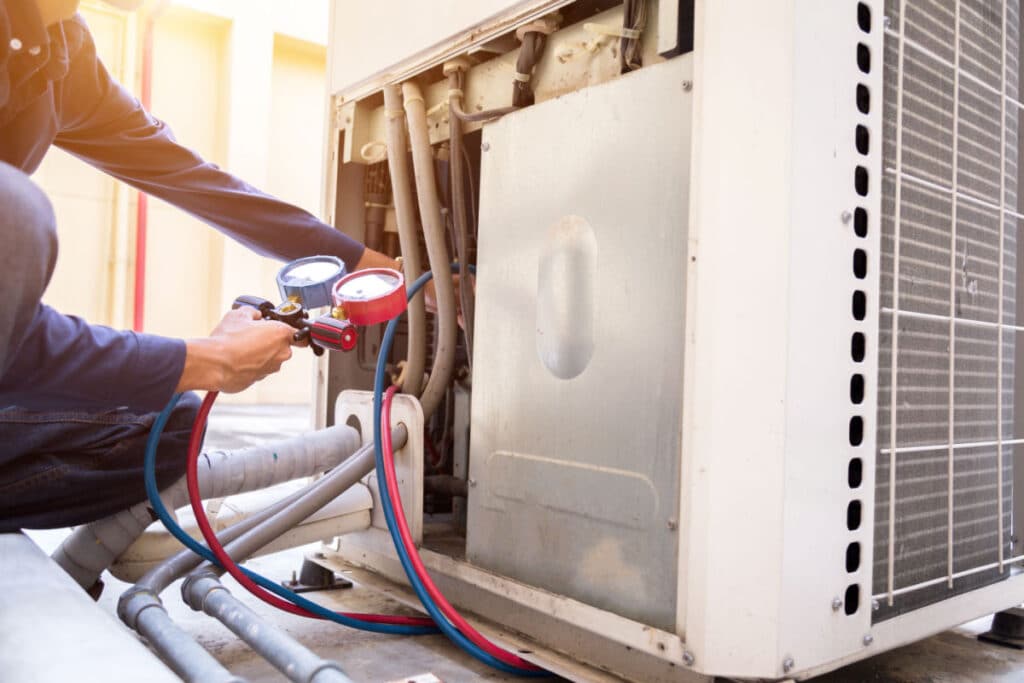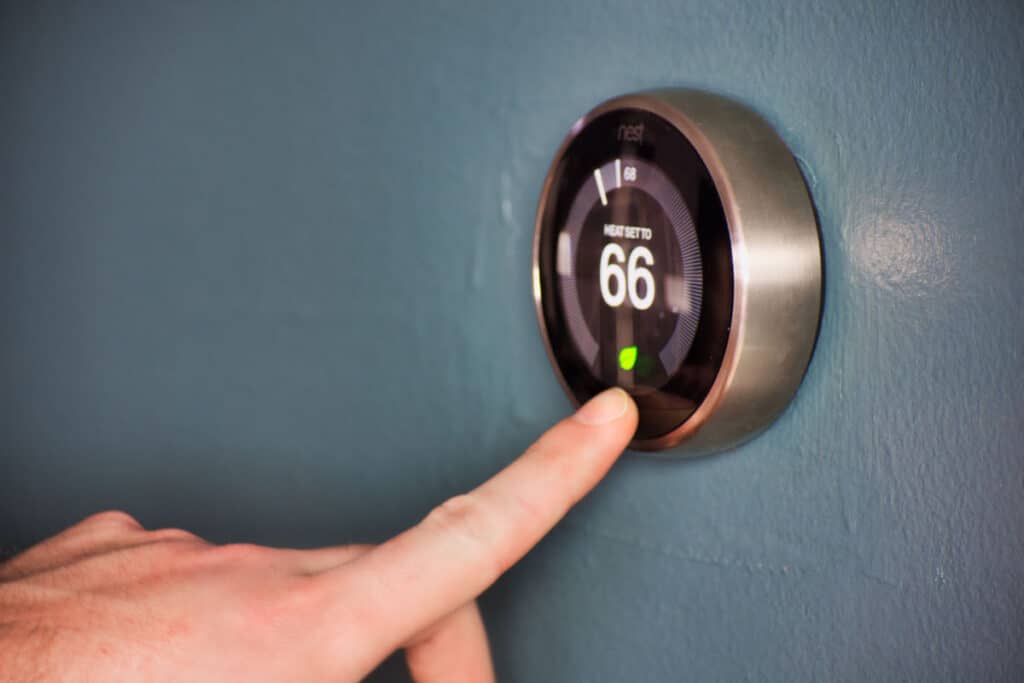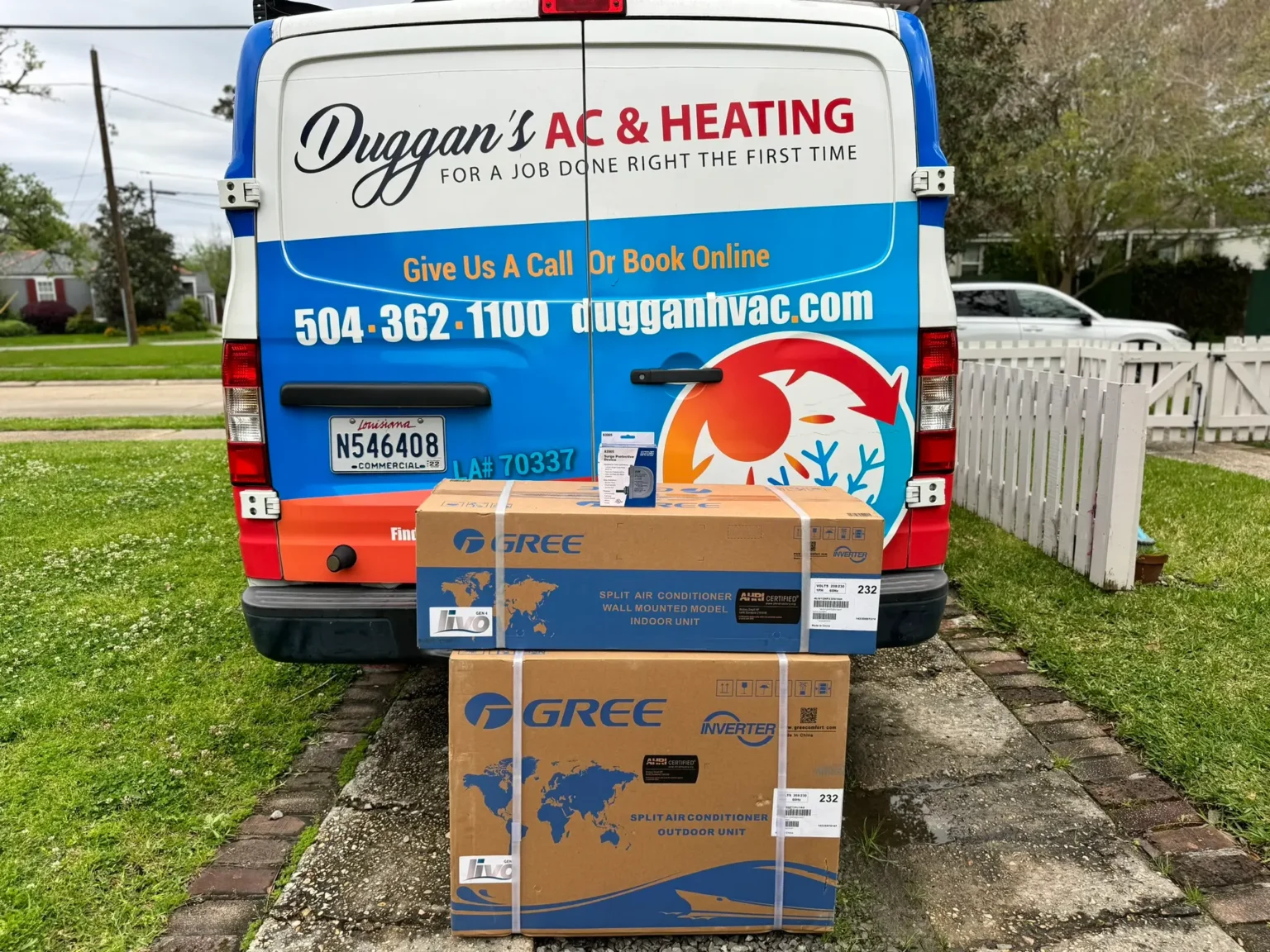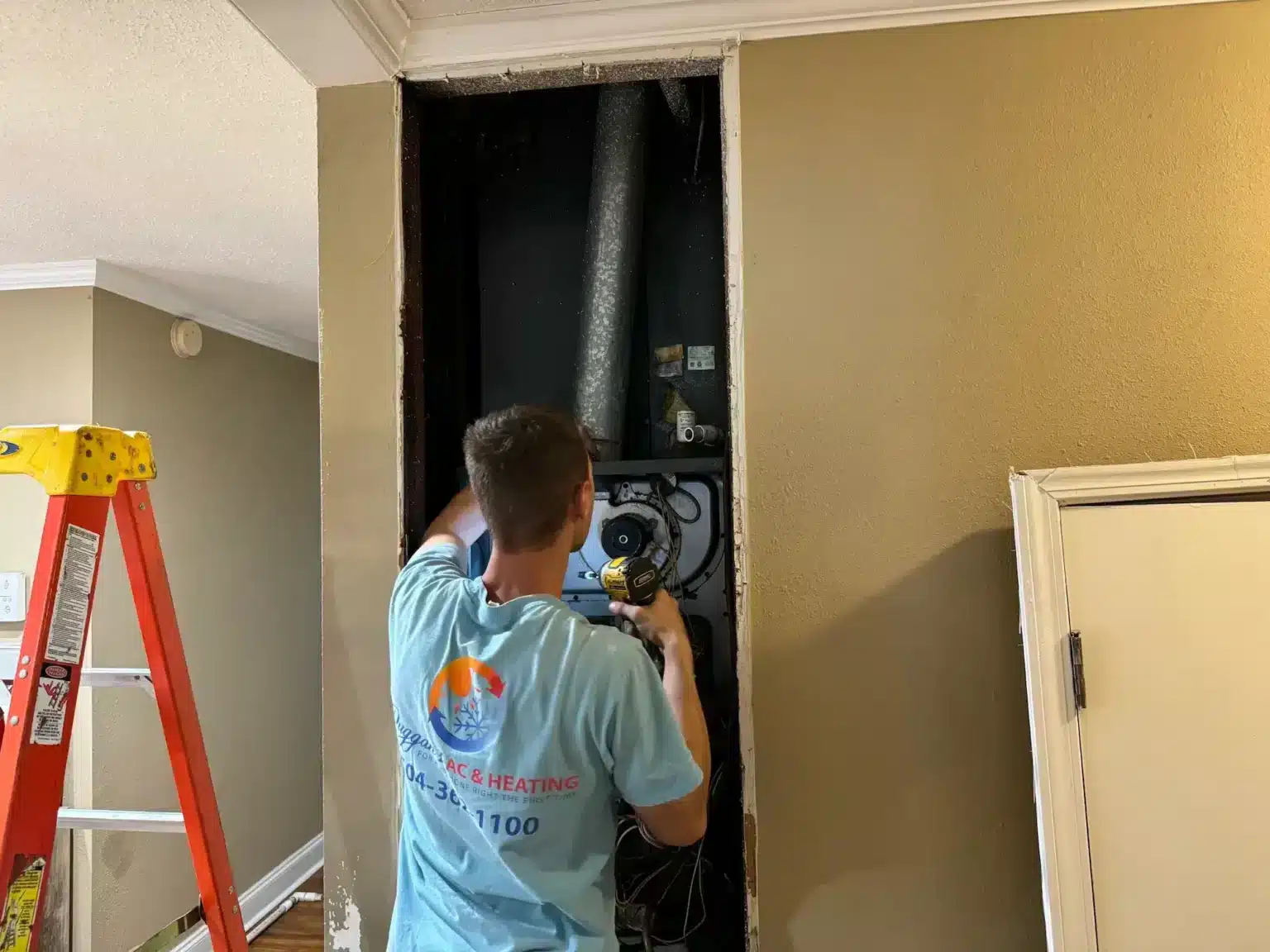The question “Why is My AC Not Cooling?” shows up every summer. The good news: many fixes start with simple steps. Duggan’s AC & Heating technicians share the same walk-through used at the doorstep. Follow these checks in order. Skip anything that doesn’t apply. If a step points to a part that needs tools or gauges, stop and book a visit. That keeps the system safe and protects the warranty.

Before anything else, think about these two rules:
- Safety first. If anything smells burnt, if the breaker keeps tripping, or if you see ice covering the lines, turn the system off at the thermostat and the breaker. Ice and repeat trips point to bigger faults that need a pro.
- Airflow wins. An air conditioner only cools well when air moves freely. Most “Why is My AC Not Cooling” calls start with a dirty filter, blocked return, or closed supply vents.
1. Thermostat Fixes That Take Seconds

Start with the easiest win: the thermostat. A small setting can stop cooling.
- Verify the mode and set point – Make sure “Cool” shows on the screen, not “Heat” or “Fan.” Set the target at least 5°F lower than the current room reading. If the screen looks dim or blank, replace the batteries, then try again.
- Switch Fan from “On” to “Auto.” – Fan “On” runs the blower nonstop and can make the home feel warm and sticky. Fan “Auto” runs only during a cooling call, which lets the coil pull moisture and cool the air.
- Give it two to three minutes – Many thermostats have a short delay to protect the compressor. If you just changed a setting, wait a couple of minutes before your next step.
Want smarter control and better comfort? A smart control helps hold steady temps and trim energy use. See Duggan’s AC & Heating page on smart thermostat options that fit local homes.
2. The Air Filter You Can Fix Right Away
A clogged filter chokes airflow, freezes the coil, and turns cold air into a weak trickle. If your air conditioning unit not cooling started after a dusty project or a long gap in filter changes, this is likely.
- Pull the filter and read the size – Common sizes look like “16x20x1” or “20x25x4.” Check the arrow on the frame and point it toward the blower when reinstalling.
- Hold the filter up to the light – If light barely passes through, swap it. If you can’t see light at all, the filter is spent and the coil may already be icing.
- Set a steady swap plan – Thin filters often need monthly checks in summer. Thicker media types last longer. For general guidance, the U.S. Department of Energy suggests regular filter checks to keep systems efficient.
If the filter was packed and the indoor coil iced up, turn the thermostat to “Off,” set the fan to “Auto,” and let ice melt for a few hours. After thawing, run cooling again. If ice returns, move to the next sections or call for service.
3. Supply and Return Vents That Must Stay Open
Air needs a way in and a way out. Closed or blocked vents turn a strong system into a weak one.
- Open every supply vent – Doors, rugs, and furniture often block vents by accident. Open them fully. Even rooms you don’t use matter because the system was sized with those vents in mind.
- Clear the return grille – Returns sit on walls, floors, or ceilings and often get covered by boxes or drapes. Dust the grille. A blocked return starves the blower and hurts cooling.
- Listen for a “whistle.” – A whistling return can mean the filter is too restrictive for the duct size or the return path is too small. That’s a sign to bring in a tech for airflow testing.
4. Outdoor Unit Steps You Can Do From The Ground
The outdoor unit needs room to breathe. Debris cuts heat release and drives head pressure up, so the ac unit not cooling gets worse as the day gets hotter.
- Clear the top and sides – Keep plants, trash bags, and tools at least two feet away. If grass clippings or cottonwood fluff coat the coil fins, gently rinse from the inside out. Spray straight, not at an angle, and keep the pressure light to avoid bending the fins.
- Check the fan – When the thermostat calls for cooling, the outdoor fan should spin. If the indoor blower runs but the outdoor fan sits still or hums, the capacitor or the fan motor may be out. Stop there and schedule repair to prevent compressor damage. Duggan’s AC & Heating handles same-day AC repair calls across the area.
- Look for blocked coil corners –Mulch stacked against the base traps heat. Pull it back. Heat must leave the coil freely or your air conditioner not blowing cold air will continue.
5. Breaker, Switches, and Float Safety
Sometimes power gets cut by a simple switch or safety.
- Outdoor service switch – Near the outdoor unit sits a small disconnect box. Make sure the pull-out or switch is seated firmly. If it looks damaged, stop and call a pro.
- Breaker panel – Central systems often have two breakers, one for the indoor air handler, one for the outdoor condenser. If either is tripped, reset once. A breaker that trips again points to a fault that needs a technician.
- Condensate safety (float switch) – Many air handlers and furnaces have a safety that stops cooling if the drain pan fills with water. Look for a small device on the drain line. If water sits in the pan or the drain pipe is clogged with slime, the safety will block cooling. Clearing drains calls for a wet-dry vacuum and cleaning solution. If that feels messy, book service so the drain gets flushed and treated right.
6. Humidity, Heat Load, and Your Space
Sometimes the system cools fine yet the home still feels warm. Heat load and moisture can swamp the space.
- Sun and air leaks – Afternoon sun through large windows adds a heavy load. Close blinds during peak hours. Weather-strip leaky doors so cool air stays inside and hot air stays out.
- Oven and long showers- Cooking and long hot showers push humidity up. High indoor moisture makes the air feel warmer even at the same temperature.
- Fans to mix air – Ceiling or box fans help move cool air across skin, which lets you set the thermostat a little higher without losing comfort. Fans don’t fix a broken AC, yet they help in normal operation.
If the home often feels sticky, a maintenance visit helps. A deep coil cleaning and correct blower speed make a big difference. Duggan’s AC & Heating offers scheduled AC maintenance plans that keep humidity control sharp.
AC Unit Signs That Point Straight to a Technician
A few symptoms mean stop DIY and get help. Pushing the unit in these cases risks major damage.
- Ice on the copper lines or indoor coil – Ice means low airflow or low refrigerant. Turn the system off and let it thaw. Running an iced unit can ruin the compressor.
- Short cycling – If the system starts and stops every few minutes, the compressor and fan take heavy stress. That can come from a bad sensor, a weak capacitor, a dirty coil, or incorrect charge.
- Outdoor unit silent, indoor blower running – The contactor, capacitor, compressor, or wiring may be at fault. Power down and schedule repair.
- Hiss or bubbling at the lines – That can mean a refrigerant leak. Refrigerant work needs EPA-certified handling and the correct tools. Duggan’s AC & Heating performs leak finds, weighs in charge the right way, and protects the system.
The Filter Was Clean, So What’s Next?
If quick checks didn’t restore strong cooling, a focused diagnostic is next. Here’s what the technician looks at on site:
- Refrigerant charge and superheat/subcool – The gauges, temperature clamps, and a chart confirm if charge sits in the target window. Low charge points to a leak. Overcharge hurts cooling and can flood the compressor. Either way, charging by guesswork doesn’t cut it.
- Indoor coil and blower wheel – A matted coil acts like a blocked filter. A dirty blower wheel throws air poorly. Professional cleaning restores airflow and cuts run time.
- Duct static pressure and hidden restrictions – Pinched flex, crushed boots, or closed fire dampers starve rooms. A static test gives a fast read on duct health. Repairs restore comfort and often lower bills.
- Thermostat sensor location and wiring – A thermostat above a lamp or near a draft reads the room wrong. Relocation or a smart type solves that problem.
- Drain line treatment – A clear drain keeps the safety from killing cooling. Techs flush the line and add a pan tab to slow slime growth.
When repair still isn’t enough, a right-sized replacement may save money in the long run. Duggan’s AC & Heating designs and installs systems that match the home’s load. See details here: Air Conditioning Installation & Replacement.
Contact Duggan’s AC & Heating for AC Repair and Services!
Neighbors search air conditioner not blowing cold air, then ask for fast service. Duggan’s AC & Heating supports the entire metro with friendly, on-time visits:
- For city homeowners, start on the main page for Air Conditioning Repair New Orleans and schedule a quick diagnostic.
- If you’re across the river, set up AC Repair Gretna and get a same-day window.
- In Jefferson Parish, use AC Repair Metairie for fast help close to home.
- Downriver residents can tap AC Repair Belle Chasse for rapid response.
Wherever you are, Duggan’s AC & Heating can move from call to fix with the right parts on the truck.
The fastest path from “Why is My AC Not Cooling?” to cold air usually starts with a thermostat check, a fresh filter, open vents, a clear outdoor coil, and a quick look at the breaker and drain safety. If those steps don’t bring the chill back, the system needs a solid diagnostic. Duggan’s AC & Heating brings the tools, the parts, and the know-how to get comfort back the right way, the first time.
For quick help, call (504) 215-7031 or use the Contact Page to pick a time.
Frequently Asked Questions
Q: The air conditioner not blowing cold air started after a storm. What should I try first?
A: Check the breaker panel for a tripped outdoor unit breaker. Reset once. If it trips again, leave it off and book repair. Storms can stress capacitors and contactors.
Q: The indoor unit runs, but the outdoor fan is silent. Could it be a bad capacitor?
A: It could. A weak capacitor is common during peak heat. Since testing and replacement require safe handling and the right microfarad match, call a pro to avoid compressor damage.
Q: Why does the system work in the morning but struggle by afternoon?
A: Afternoon sun raises the heat load, and an outdoor coil covered in fluff or a slightly low refrigerant level can’t keep up. Cleaning and a charge check usually solve it.
Q: How often should filters get changed in summer?
A: Check monthly. Homes with pets or renovations may need faster swaps. Thicker media filters can last longer, yet they still need inspection.
Q: Is ice on the copper line a big problem?
A: Yes. Ice means airflow or charge trouble. Shut the system down and let it thaw. Call for service so the real cause gets fixed.
Q: Will a smart control help with short cycling?
A: Smart models can improve staging and run time on compatible systems, yet short cycling often points to a setup or mechanical issue. A diagnostic visit sorts that out.




